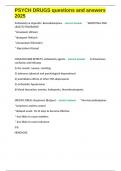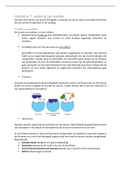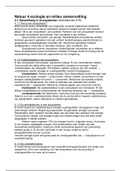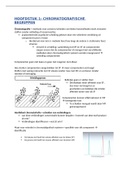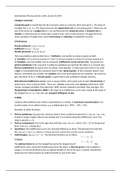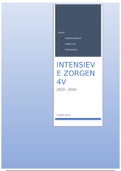Human Neurophysiology 2023
VU Amsterdam
Contents
Lecture 1b – Spontaneous brain activity, thoughts and feelings ................................................................................. 1
Lecture 2a – neuronal basis of EEG, EEG demo and computer practical primer ......................................................... 4
Lecture 2b – NBT and computer practical primer ........................................................................................................ 8
Lecture 3 – basics of DSP and oscillations .................................................................................................................... 9
Lecture 4a – oscillations, NBT tutorials and project possibilities ............................................................................... 14
Lecture 4b – Nora Hagopian, seeking resilience of heart and brain (37 minutes)..................................................... 18
Lecture Nathalie Goriounova (40 minutes) ............................................................................................................... 19
Lecture 5 The theory of critical brain dynamics (100 minutes, old lecture) .............................................................. 21
Lecture 6 synchrony and projects (niet online?)........................................................................................................ 28
Lecture 7 biomarkers of brain disorders (55 minutes) .............................................................................................. 34
Lecture 8 Bran computer interfaces and neurofeedback (80 minutes) .................................................................... 37
Lecture 1b – Spontaneous brain activity, thoughts and feelings
What is cognitive neuroscience?
, • Combined study of mind and brain revolutionized by neuroimaging techniques.
• Allows exploring the biology of conscious experience, unconscious processes, the disordered mind.
• Aims to improve also diagnosis and treatment of brain disorders and increasingly inspires artificial
intelligence (cognitive computing)
PET: positron emission tomography imaging: not used in this course but still important
• Radioactive material is injected, then radioactive material accumulates in brain areas that are
metabolically active.
• Decay of FDG (radioactive material) gives off a neutron and a positron, positron hits an electron and
annihilates into 2 gamma rays, which are detected.
Downsides;
- Metabolic imaging with PET has poor temporal resolution (10-20s)
- Limits to how much radioactive material you can give to a patient
- Different brain parts are metabolically active at their own standard level, on activities some parts get more
active, this relies on subtraction of measurements.
fMRI has replaced PET:
• fMRI is an indirect measure of brain activity
• No radioactive material and better resolutions
• fMRI = BOLD response (blood-oxygenation-level-dependent signal)
• With neuronal activity, the brain consumes more energy, it gets that from the oxygenated haemoglobin.
Increase of oxygenated haemoglobin in a brain area is called the hemodynamic response. Oxygenated and
deoxygenated haemoglobin have different magnetic properties, imaged with fMRI
• It is a delayed imaging of brain activity as activity will take place and secondary blood flow happens which
is detected. 95% of the brain shows task-related activity
Baseline problem:
• In 1997 two states of the brain get analysed and subtracted to find differences
• They thought the brain at rest is doing nothing, this is not the case
• They found when they gave the brain a task then certain brain areas would have decreased activity. The
areas that decreased correspond to areas with high resting-state metabolism
• Default mode network: punt, midden en zijkant of brain is always active, but not during tasks. All three
areas create the same BOLD signals during rest, synchronized. The brain's default network is a set of
regions that is spontaneously active during passive moments.
• By finding synchronized areas on hemodynamics, we can find intrinsically correlated regions
• Little and indirect evidence for functional role of default mode network
• Theory of mind: mind wandering is often on some-one you know, putting yourself in the shoe of another
seems to activate the default mode network, as well as envisioning the future, so no distinct function.
Questions accompanied with theory of mind are;
1. I thought about others
2. I thought about people I like
3. I placed myself in other peoples shoes
Why is mind wandering important?
• Smartphone allowed new tools for cognitive research
• Wandering mind is unhappy mind, 47% of the people were mind wandering
Questions asked during the mind wandering experiment;
- How are you feeling right now?
- What are you doing right now
- Are you thinking about something other than what you’re currently doing
,ARSQ questionnaire
- 1; are you comfortable with closing your eyes?
Then you are also most likely to be in control of
your thought
- 2; comfort with closing your eyes has nothing to
do with if you think about other people
- 3; the more you think about people the more
likely you are to also make plans with them
; resting state cognition predicts depressive
symptoms
These people have low comfort level when closing
their eyes and have less control of their thoughts.
, Lecture 2a – neuronal basis of EEG, EEG demo and computer practical primer
Learning objectives: You can explain:
- The relation between neuronal activity and EEG signals.
- The possibilities and limitations for interpreting the amplitude or scalp distribution of EEG fields.
- The units and typical magnitudes of EEG parameters.
- What is “spatial and temporal resolution” …and why the resolutions are as they are.
- The usefulness of EEG measurements by way of examples.
Why research with EEG?
- First EEG in humans was 100 years ago thus it exists for a long time but no real advances
- To look into functional significance of mass-neuronal activity
- Inexpensive and safe brain-computer interface (BCI)
- Fundamental knowledge, free-will and consciousness research
- Brain disorders: 35% of healthcare costs, but only 50% of all brain disorders is treated
- Real-time feedback on your brain activity: possible treatment using brain plasticity
- EEG is behind on other physiological measurements: we have no proper analysis tools on brain data
(when are values critical etc)
Advantages of EEG
- Direct reflection of activity
- High temporal resolution (~1ms) = no delay but less
spatial resolution
- What is spatial vs temporal resolution; In a nutshell,
spatial resolution refers to the capacity a technique
has to tell you exactly which area of the brain is
active, while temporal resolution describes its ability
to tell you exactly when the activation happened.
- PLAATJE: where has activity taken place can be
determined with an accuracy of 1cm
- One fMRI reading generates multiple oscillations
with distinct functions, it gives information on a
block of brain
- Increasingly portable: EEG devices
- Non- invasive
- Available (almost in every hospital)
- Inexpensive
Abbreviations:
- EEG = Electroencephalography
- fMRI = functional magnetic resonance imaging, detects blood flow related to neuronal activity
- PET = Positron emission tomography
- MEG = Magnetoencephalography
VU Amsterdam
Contents
Lecture 1b – Spontaneous brain activity, thoughts and feelings ................................................................................. 1
Lecture 2a – neuronal basis of EEG, EEG demo and computer practical primer ......................................................... 4
Lecture 2b – NBT and computer practical primer ........................................................................................................ 8
Lecture 3 – basics of DSP and oscillations .................................................................................................................... 9
Lecture 4a – oscillations, NBT tutorials and project possibilities ............................................................................... 14
Lecture 4b – Nora Hagopian, seeking resilience of heart and brain (37 minutes)..................................................... 18
Lecture Nathalie Goriounova (40 minutes) ............................................................................................................... 19
Lecture 5 The theory of critical brain dynamics (100 minutes, old lecture) .............................................................. 21
Lecture 6 synchrony and projects (niet online?)........................................................................................................ 28
Lecture 7 biomarkers of brain disorders (55 minutes) .............................................................................................. 34
Lecture 8 Bran computer interfaces and neurofeedback (80 minutes) .................................................................... 37
Lecture 1b – Spontaneous brain activity, thoughts and feelings
What is cognitive neuroscience?
, • Combined study of mind and brain revolutionized by neuroimaging techniques.
• Allows exploring the biology of conscious experience, unconscious processes, the disordered mind.
• Aims to improve also diagnosis and treatment of brain disorders and increasingly inspires artificial
intelligence (cognitive computing)
PET: positron emission tomography imaging: not used in this course but still important
• Radioactive material is injected, then radioactive material accumulates in brain areas that are
metabolically active.
• Decay of FDG (radioactive material) gives off a neutron and a positron, positron hits an electron and
annihilates into 2 gamma rays, which are detected.
Downsides;
- Metabolic imaging with PET has poor temporal resolution (10-20s)
- Limits to how much radioactive material you can give to a patient
- Different brain parts are metabolically active at their own standard level, on activities some parts get more
active, this relies on subtraction of measurements.
fMRI has replaced PET:
• fMRI is an indirect measure of brain activity
• No radioactive material and better resolutions
• fMRI = BOLD response (blood-oxygenation-level-dependent signal)
• With neuronal activity, the brain consumes more energy, it gets that from the oxygenated haemoglobin.
Increase of oxygenated haemoglobin in a brain area is called the hemodynamic response. Oxygenated and
deoxygenated haemoglobin have different magnetic properties, imaged with fMRI
• It is a delayed imaging of brain activity as activity will take place and secondary blood flow happens which
is detected. 95% of the brain shows task-related activity
Baseline problem:
• In 1997 two states of the brain get analysed and subtracted to find differences
• They thought the brain at rest is doing nothing, this is not the case
• They found when they gave the brain a task then certain brain areas would have decreased activity. The
areas that decreased correspond to areas with high resting-state metabolism
• Default mode network: punt, midden en zijkant of brain is always active, but not during tasks. All three
areas create the same BOLD signals during rest, synchronized. The brain's default network is a set of
regions that is spontaneously active during passive moments.
• By finding synchronized areas on hemodynamics, we can find intrinsically correlated regions
• Little and indirect evidence for functional role of default mode network
• Theory of mind: mind wandering is often on some-one you know, putting yourself in the shoe of another
seems to activate the default mode network, as well as envisioning the future, so no distinct function.
Questions accompanied with theory of mind are;
1. I thought about others
2. I thought about people I like
3. I placed myself in other peoples shoes
Why is mind wandering important?
• Smartphone allowed new tools for cognitive research
• Wandering mind is unhappy mind, 47% of the people were mind wandering
Questions asked during the mind wandering experiment;
- How are you feeling right now?
- What are you doing right now
- Are you thinking about something other than what you’re currently doing
,ARSQ questionnaire
- 1; are you comfortable with closing your eyes?
Then you are also most likely to be in control of
your thought
- 2; comfort with closing your eyes has nothing to
do with if you think about other people
- 3; the more you think about people the more
likely you are to also make plans with them
; resting state cognition predicts depressive
symptoms
These people have low comfort level when closing
their eyes and have less control of their thoughts.
, Lecture 2a – neuronal basis of EEG, EEG demo and computer practical primer
Learning objectives: You can explain:
- The relation between neuronal activity and EEG signals.
- The possibilities and limitations for interpreting the amplitude or scalp distribution of EEG fields.
- The units and typical magnitudes of EEG parameters.
- What is “spatial and temporal resolution” …and why the resolutions are as they are.
- The usefulness of EEG measurements by way of examples.
Why research with EEG?
- First EEG in humans was 100 years ago thus it exists for a long time but no real advances
- To look into functional significance of mass-neuronal activity
- Inexpensive and safe brain-computer interface (BCI)
- Fundamental knowledge, free-will and consciousness research
- Brain disorders: 35% of healthcare costs, but only 50% of all brain disorders is treated
- Real-time feedback on your brain activity: possible treatment using brain plasticity
- EEG is behind on other physiological measurements: we have no proper analysis tools on brain data
(when are values critical etc)
Advantages of EEG
- Direct reflection of activity
- High temporal resolution (~1ms) = no delay but less
spatial resolution
- What is spatial vs temporal resolution; In a nutshell,
spatial resolution refers to the capacity a technique
has to tell you exactly which area of the brain is
active, while temporal resolution describes its ability
to tell you exactly when the activation happened.
- PLAATJE: where has activity taken place can be
determined with an accuracy of 1cm
- One fMRI reading generates multiple oscillations
with distinct functions, it gives information on a
block of brain
- Increasingly portable: EEG devices
- Non- invasive
- Available (almost in every hospital)
- Inexpensive
Abbreviations:
- EEG = Electroencephalography
- fMRI = functional magnetic resonance imaging, detects blood flow related to neuronal activity
- PET = Positron emission tomography
- MEG = Magnetoencephalography

